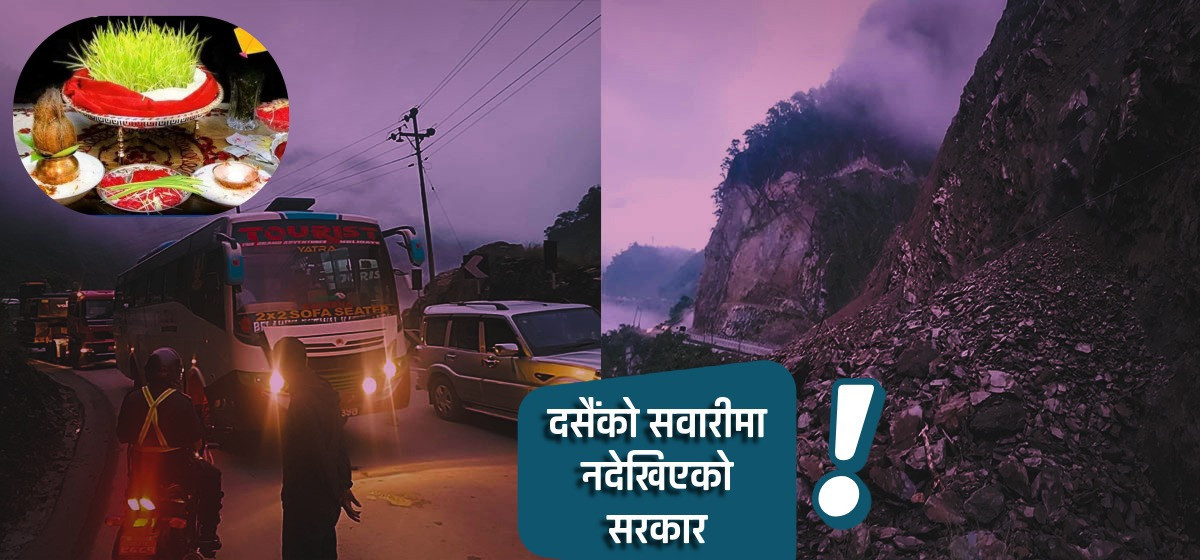KATHMANDU, Sept 24: As major festivals like Dashain and Tihar approach, there has been a significant increase in the number of travelers leaving the Kathmandu Valley to return to their hometowns. The government issued route permits for public vehicles starting from the first day of Ghatasthapana, which provided some relief to passengers. However, landslides caused by continuous rains have blocked major highways across the country, resulting in considerable difficulties for those traveling in and out of the Valley.
Routes that usually take five hours to traverse are now taking over fifteen, leaving many who have yet to start their journeys feeling anxious. "The government hasn't fulfilled its responsibilities properly, and the public is suffering," said Min Sherpa from Chitwan, who has been waiting for the roads to be cleared before leaving Kathmandu. "The roads are in this condition—how are we supposed to get home? It's worrying."
Having traveled to China multiple times, Sherpa dreams of experiencing the wide, smooth roads found there. He criticizes Nepal’s democracy for prioritizing the interests of political leaders over those of ordinary citizens. He stated, “Ordinary citizens can hardly live their daily lives with ease. During festivals, the government should be present on the roads. When the roads are smooth, people can travel happily, and their festivals become joyful. But here, the government is nowhere to be seen.”
For travelers during Dashain, the biggest challenge has been the Muglin–Narayangadh road, where landslides happen almost daily. After workers clear a slide and briefly reopen the route, vehicles attempt to pass—only for another landslide to close it again.
DoR constructs over 36,000 kilometers of roads across Nepal so...

When sudden landslides strike at night, thousands of passengers and transport workers are left stranded. Many are forced to take alternative routes, enduring long and difficult journeys.
“We must travel regardless of the circumstances, but landslides occur repeatedly,” said driver Kumar Pudasaini, who drives the Muglin–Narayangadh road. “You can never predict when or where one will happen. We travel in constant fear.”
According to the Federation of Nepalese National Transport Entrepreneurs (FNNTE), irregular road conditions have made operating transport services extremely difficult. Most buses that left the Valley have not returned on time, creating problems for passengers who booked tickets in advance.
“We have buses that travel outside the Valley, and we even arrange tickets a day in advance,” said the Federation’s treasurer, Gyanendra Shrestha. “But with passengers stranded on the roads and the risk of more trouble, it’s hard to send buses out of the Valley from the bus park.”
Shrestha said the FNNTE is doing everything possible to avoid a shortage of buses during the festival season. “We’ve done all we can, even issuing tickets a day early to reassure passengers. But the condition of the roads is creating problems,” he said. He stressed that the government needs to pay much more attention to road conditions during the holidays. “During festivals, the government should be visible on the roads. When roads are smooth, people can travel happily and celebrate with ease. But here, the government is nowhere to be seen.”
As of Monday, landslides had blocked traffic to and from the Valley at 13 locations nationwide.
Infrastructure expert Ashish Gajurel argues that the government views road construction solely as a means of transport management, neglecting necessary systemic reforms. As a result, travelers are forced to endure the same difficulties each year. “The primary cause of landslides in Nepal is the instability of the hills. The government believes that simply blacktopping a road is sufficient,” he said. “However, it fails to take into account the geological risks that arise from blasting hillsides, which is why these issues occur almost daily.”
Gajurel explains that landslides occur because authorities neglect to assess the slopes created during road construction or to address potential hazards. On one hand, river erosion is a contributing factor, while on the other hand, there is a lack of investment in roads. Furthermore, when technical teams are unable to advocate for measures to mitigate risks associated with road construction, the problem continues to escalate.





































